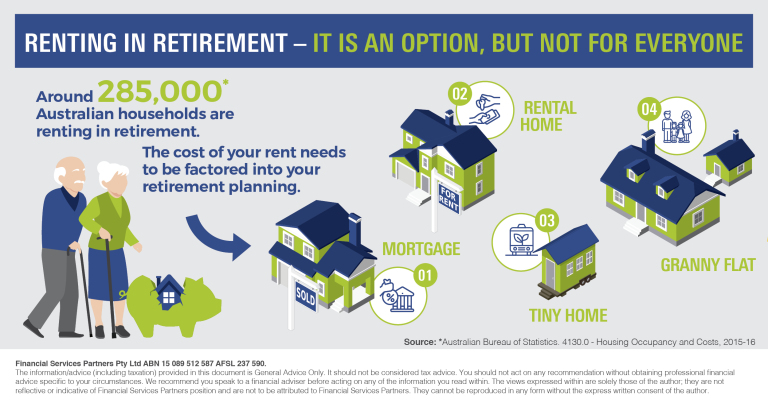For many Australians transitioning into retirement, the increasing cost of housing is a hindrance on people’s ability to pay off their property before they retire, and this may push them into a few common scenarios:
- Being forced to sell the family home prior to retirement and renting
- Continuing to pay down the mortgage on the home they live in, but leave beneficiaries with an asset that has debt owing
- Long-term renting due to lack of affordable properties on the market
- Short-term renting in different locations as a way of chasing the nomadic lifestyle dream without the financial burden of a mortgage.
Deciding where and how you want to live is a decision-making process fraught with stress, whether you’re about to retire or you’re a young adult watching your parents prepare for their retirement. A recent survey by National Seniors Australia outlined that many people worry they will run out of savings and investments in retirement. Women worry more about retirement savings than men, worrying is 65% higher in people who have less than $500,000 in savings and 53% higher worry in people who expect their main source of income in retirement to be the Age Pension.[1]
How much money do you need to retire comfortably in Australia?
According to the Association of Superannuation Funds of Australia (ASFA), there are two broad categories of lifestyles in retirement — comfortable or modest. A comfortable retirement affords people a good car, top-tier private health insurance, dining out on regular occasions, travel, and other lifestyle factors you enjoyed while working. In a modest retirement, you may be entitled to the Age Pension, but you’ll only be able to afford a basic lifestyle, with limited funds available for small luxuries.
How much do you need to live on?
There are facts and figures from industry bodies and experts, but your retirement lifestyle is unique to you, so mapping out your retirement plan with a financial adviser can give you a clearer picture on what you will be able to afford. As a benchmark for comparing, here are some widely touted figures:
- A couple of about 65 years of age – $40,194pa is needed to live modestly.
- A couple of about 65 years of age – $61,786pa is needed to live comfortably.
- For singles of about 65 years of age – $27,913pa is needed to live modestly.
- For singles of about 65 years of age – $43,787pa I needed to live comfortably.[2]
How can renting affect your retirement income?
While these numbers help you understand cost of living in retirement, things become complicated if you don’t own your home. The Association of Superannuation Funds of Australia (ASFA) calculate based on the assumption that retirees will own their home before retiring, therefore not need to allocate money towards mortgage repayments or rent in the household budget.
However, the Australian Bureau of Statistics (ABS) report that around 285,000 Australian households are renting in retirement. While renting may afford you the ability to live in a more desirable location than if you owned a property, the cost of your rent still needs to be factored into your retirement planning and therefore the numbers provided by ASFA need to be tweaked if you are renting in retirement. And this will blow out the figures of what annual income you need to have access to in retirement.
Can you rent and afford a comfortable retirement?
Based on the ASFA’s calculations, if you retire in Sydney you would need $1,166,000 as a couple or $1,045,000 as a single to afford a comfortable retirement lifestyle whilst renting. While this number may be slightly lower for other cities and regional centres where rental prices are lower, it provides a more realistic calculation of exactly how much your retirement nest egg should be if you’ll be renting in retirement. Having a greater understanding of how you can structure your super funds in the accumulation and drawdown phases can help you be better prepared.
As with other passive investments, you need to ensure you’re not drawing down so much capital each year that your balance isn’t compounding at an adequate rate to provide you with enough retirement income for the rest of our life.
For example, if the average return on your super balance is 9% per year, it’s wise to drawdown 4% or less of your balance each year so you can maintain adequate funds throughout retirement, which may be longer than you think. A good financial adviser can work through the calculations based on your individual circumstances, factoring home ownership or rent and any Centrelink benefits you are entitled to, so you can live the retirement lifestyle you want without a fear of running out of money.
What if you don’t want to rent in retirement?
If you don’t own a home and you’re not keen on renting, there are other options. Maybe you want the freedom of living in a motor home, setting up in a modern tiny home, basing yourself in a retirement village, securing granny flat rights, or, living on a cruise ship. While these options may not be for everyone, the very nature of retirement, can give you the flexibility to live a nomadic lifestyle with a smaller carbon footprint. If you’re interested in staying in one place, a retirement village or granny flat can provide you with that lifestyle.
There is no one size fits all
When it comes to your retirement dreams and finances, your picture looks different to the next person. If you don’t own your home, you’ll need to factor the cost of rent into your retirement planning to ensure your nest egg and the annual income you’ll draw is enough to provide your desired retirement lifestyle. If you do own your home you won’t have to worry about the mortgage or rent, but what about home improvements and modifications as you age?
With so many different scenarios to consider, it is wise to work through your options with your financial adviser.
Notes
[1] https://nationalseniors.com.au/uploads/0120203573PAR-RetirementIncomeWorry-ChallengerRpt-FNREV_1.pdf
[2] https://www.superannuation.asn.au/resources/retirement-standard as at September 2019.
Source
The figures quoted in this article are sourced from the ASFA Retirement Standard, March quarter 2019 report, https://www.superannuation.asn.au/resources/retirement-standard.
DISCLAIMER
Financial Services Partners Pty Ltd
www.financialservicespartners.com.au
ABN 15 089 512 587 AFSL 237 590. The information/advice (including taxation) on this website is General Advice Only. It has been prepared without taking into account any of your individual objectives, financial situation or needs. Before acting on this advice you should consider the appropriateness of the advice, having regard to your own objectives, financial situation and needs. You should obtain a Product Disclosure Statement relating to the products mentioned, and consider the statements before making any decision about whether to acquire products or services.
We take your privacy seriously and as such we, or any of the Financial Services Partners financial advisers, will never ask you to transfer money via email request unless we have spoken to you in person or the transfer is part of an existing arrangement between you and your financial adviser. If you receive any such requests that are outside the agreed arrangements you have with your financial adviser, please contact our office immediately to confirm the validity the request before you take any action – .
The views expressed in this publication are solely those of the author; they are not reflective or indicative of the Licensee’s position and are not to be attributed to the Licensee. They cannot be reproduced in any form without the express written consent of the author.






